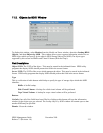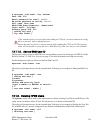Chapter 12. Tape Aggregation
This chapter discusses the following operations:
• Overview of Tape Aggregation
• Tape Aggregation Performance Considerations
• Configuring Tape Aggregation
12.1. Overview of Tape Aggregation
Tape aggregation reduces file processing time when migrating relatively small files from disk to
tape. In certain situations it may improve very small file disk-to-tape migration performance by
two orders of magnitude over normal migration.
During normal migration, HPSS migrates each file into a separate tape segment. This generally causes
the tape drive to flush the file data to the tape, and write a tape mark. It is not unusual for the majority of
the time spent migrating small files to be dominated by this.
If tape aggregation is enabled in the Disk Migration Policy, and if there are a sufficient number of
migration candidate files ready to be migrated, HPSS will pack the data of many small files into a single
tape storage segment and only write a single tape mark for the entire "batch".
Note that this is managed internally by HPSS and is transparent to users. For example, it has no effect on
file security or how files are accessed. It generally has little effect on file retrieval performance.
12.2. Tape Aggregation Performance Considerations
In order to get good performance with tape aggregation, there are several things to consider.
First, there need to be a sufficient number of files ready to migrate. If migration runs too often, or if the
HPSS system doesn't tend to ingest a large number of small files in a relatively short period of time, then
there may be little or no benefit to tape aggregation since there will be very few files, if any, in each
aggregate.
Second, tape aggregation performs best with relatively small files since most of the time spent to migrate
them occurs during tape mark processing when the data is flushed to the media. It usually isn't useful to
aggregate large files since the tape mark processing time is dominated by the time needed to write the file
data.
Finally, tape aggregates are currently written as a unit. If there is a problem writing a very large
aggregate (e.g. end of media is reached) the entire aggregate will need to be rewritten again later. If the
aggregate is very large (e.g. 10% of a large capacity tape), this may take a long time. In general it is
more important to set up your Disk Migration Policy so that a large majority of the total number of files
you expect to receive are put into aggregates, rather than being overly concerned with the amount of data
being put into aggregates.
12.3. Configuring Tape Aggregation
To turn on tape aggregation, make sure the Aggregate Files to Tape option is enabled on the Disk
HPSS Management Guide November 2009
Release 7.3 (Revision 1.0) 323


















